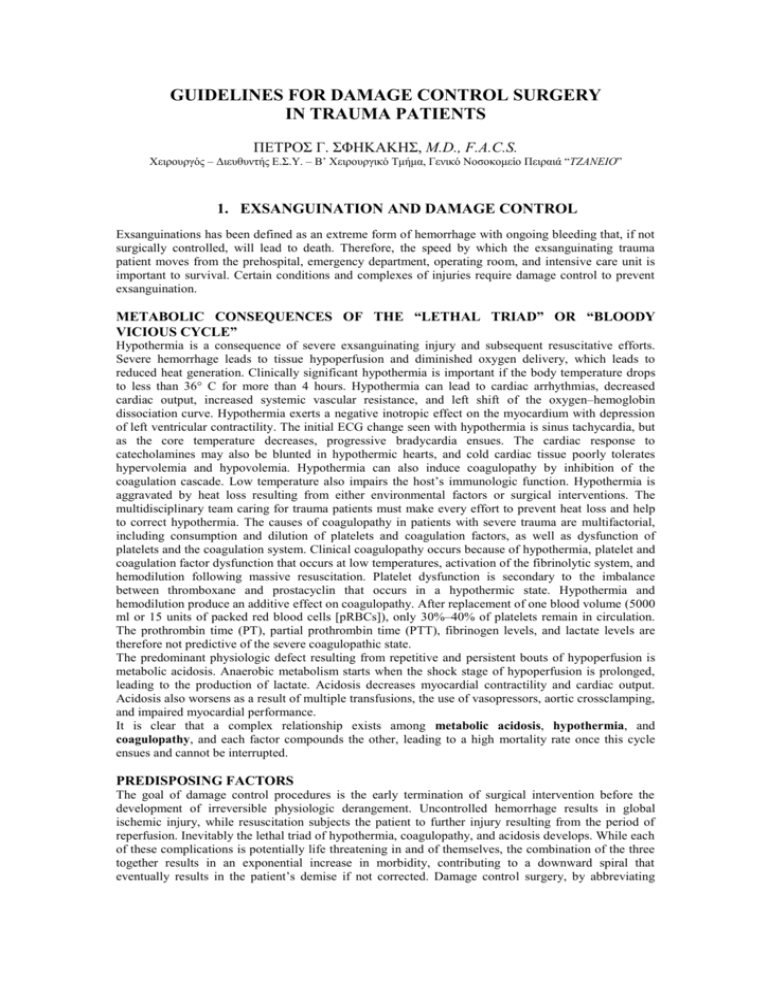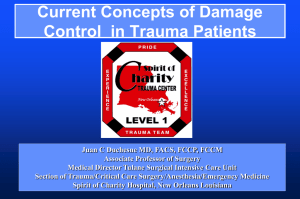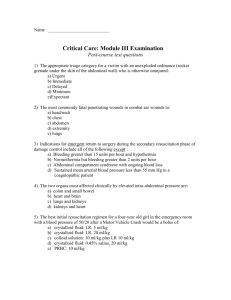in trauma patients
advertisement

GUIDELINES FOR DAMAGE CONTROL SURGERY IN TRAUMA PATIENTS ΠΕΤΡΟΣ Γ. ΣΦΗΚΑΚΗΣ, M.D., F.A.C.S. Χειρουργός – Διευθυντής Ε.Σ.Υ. – Β’ Χειρουργικό Τμήμα, Γενικό Νοσοκομείο Πειραιά “ΤΖΑΝΕΙΟ” 1. EXSANGUINATION AND DAMAGE CONTROL Exsanguinations has been defined as an extreme form of hemorrhage with ongoing bleeding that, if not surgically controlled, will lead to death. Therefore, the speed by which the exsanguinating trauma patient moves from the prehospital, emergency department, operating room, and intensive care unit is important to survival. Certain conditions and complexes of injuries require damage control to prevent exsanguination. METABOLIC CONSEQUENCES OF THE “LETHAL TRIAD” OR “BLOODY VICIOUS CYCLE” Hypothermia is a consequence of severe exsanguinating injury and subsequent resuscitative efforts. Severe hemorrhage leads to tissue hypoperfusion and diminished oxygen delivery, which leads to reduced heat generation. Clinically significant hypothermia is important if the body temperature drops to less than 36° C for more than 4 hours. Hypothermia can lead to cardiac arrhythmias, decreased cardiac output, increased systemic vascular resistance, and left shift of the oxygen–hemoglobin dissociation curve. Hypothermia exerts a negative inotropic effect on the myocardium with depression of left ventricular contractility. The initial ECG change seen with hypothermia is sinus tachycardia, but as the core temperature decreases, progressive bradycardia ensues. The cardiac response to catecholamines may also be blunted in hypothermic hearts, and cold cardiac tissue poorly tolerates hypervolemia and hypovolemia. Hypothermia can also induce coagulopathy by inhibition of the coagulation cascade. Low temperature also impairs the host’s immunologic function. Hypothermia is aggravated by heat loss resulting from either environmental factors or surgical interventions. The multidisciplinary team caring for trauma patients must make every effort to prevent heat loss and help to correct hypothermia. The causes of coagulopathy in patients with severe trauma are multifactorial, including consumption and dilution of platelets and coagulation factors, as well as dysfunction of platelets and the coagulation system. Clinical coagulopathy occurs because of hypothermia, platelet and coagulation factor dysfunction that occurs at low temperatures, activation of the fibrinolytic system, and hemodilution following massive resuscitation. Platelet dysfunction is secondary to the imbalance between thromboxane and prostacyclin that occurs in a hypothermic state. Hypothermia and hemodilution produce an additive effect on coagulopathy. After replacement of one blood volume (5000 ml or 15 units of packed red blood cells [pRBCs]), only 30%–40% of platelets remain in circulation. The prothrombin time (PT), partial prothrombin time (PTT), fibrinogen levels, and lactate levels are therefore not predictive of the severe coagulopathic state. The predominant physiologic defect resulting from repetitive and persistent bouts of hypoperfusion is metabolic acidosis. Anaerobic metabolism starts when the shock stage of hypoperfusion is prolonged, leading to the production of lactate. Acidosis decreases myocardial contractility and cardiac output. Acidosis also worsens as a result of multiple transfusions, the use of vasopressors, aortic crossclamping, and impaired myocardial performance. It is clear that a complex relationship exists among metabolic acidosis, hypothermia, and coagulopathy, and each factor compounds the other, leading to a high mortality rate once this cycle ensues and cannot be interrupted. PREDISPOSING FACTORS The goal of damage control procedures is the early termination of surgical intervention before the development of irreversible physiologic derangement. Uncontrolled hemorrhage results in global ischemic injury, while resuscitation subjects the patient to further injury resulting from the period of reperfusion. Inevitably the lethal triad of hypothermia, coagulopathy, and acidosis develops. While each of these complications is potentially life threatening in and of themselves, the combination of the three together results in an exponential increase in morbidity, contributing to a downward spiral that eventually results in the patient’s demise if not corrected. Damage control surgery, by abbreviating surgical intervention and returning the patient to the ICU for correction of the lethal triad, has resulted in improved mortality over time. Hypothermia is defined as a core temperature of less than 35° C. The reasons for hypothermia after trauma include aggressive resuscitation with unwarmed fluids, exposure at the time of the primary and secondary survey with radiant heat loss to the environment, and evaporative loss from exposed peritoneal and pleural surfaces in the operating room. The incidence of clinical hypothermia after trauma laparotomy is 57%. Hypothermia has clearly been shown to increase mortality, increasing significantly in patients with a core temperature less than 34° C, and approaching 100% in patients with a core temperature less than 32° C. Hypothermia has systemic effects, including negative impact on hemodynamics (decreased heart rate and cardiac output, increased systemic vascular resistance), renal function (decreased glomerular filtration rates), and central nervous system depression. Hypothermia also independently affects the coagulation cascade, as clot formation relies on a series of temperature dependent enzymatic reactions. Studies have clearly demonstrated increases in prothrombin time (PT), thrombin time, and partial thromboplastin time (PTT). Hypothermia also affects platelet function, leading to sequestration in the portal circulation and prolonged bleeding times. Metabolic acidosis occurs after hemorrhagic shock because of the switch from aerobic to anaerobic metabolism during periods of hypoperfusion. The detrimental effects of acidosis include depressed myocardial contractility and a diminished response to inotropic medications. Acidosis predisposes the myocardium to ventricular dysrhythmias and can worsen intracranial hypertension. Finally, acidosis has been shown to worsen coagulopathy by independently prolonging PTT and decreasing Factor V activity. Acidosis has been linked to the development of disseminated intravascular coagulation (DIC) and may exacerbate a consumptive coagulopathy. Hypothermia, acidosis, and coagulopathy develop secondary to the dilutional effects when massive resuscitation initially is comprised of crystalloid and packed red blood cells without the addition of clotting factor replacement. Exposed tissue factor secondary to tissue injury also contributes to the development of coagulopathy through the activation of the clotting cascade and resultant consumption of clotting factors. PATIENT SELECTION Not all trauma patients require damage control measures. In addition to the physiologic guidelines of damage control certain conditions and complexes of injuries assessed both preoperatively and intraoperatively require damage control. Multiple mass casualties predict the need for damage control. In the multiply injured trauma patient sustaining major abdominal injury, the need to evaluate for other extra-abdominal injuries in a timely fashion may also indicate damage control. The preoperative duration of hypotension (systolic blood pressure<90 mm Hg) was significantly different in those patients that exsanguinated as compared with survivors (45 minutes vs. 85 minutes). Therefore, in addition to other factors such as the preoperative assessment of hypothermia and coagulopathy, a period of sustained hypotension greater than 60 minutes would predict the need for damage control. Intraoperatively, certain complexes of injuries also predict the need for this technique. These injuries include major abdominal vascular, complex hepatic, major thoracic vascular injuries, and the need for intraoperative thoracotomy. Patients with exsanguination are perhaps the best candidates to undergo damage control. TECHNIQUE OF DAMAGE CONTROL Injury severity and spectrums of injury have continually evolved, resulting in greater and different challenges for the modern trauma surgeon. High energy blunt trauma, with resultant multisystem organ injury, as well as increasingly sophisticated firearms with greater wounding capacity, has resulted in greater severity of injury. Despite the fact that these injury patterns are more likely to result in the death of a patient, improvements in prehospital transport and trauma resuscitation have allowed more moribund patients to reach the hospital alive but in extremis. Damage control surgery, addressing the life-threatening injuries immediately but delaying definitive repair until the metabolic and physiologic perturbations have been corrected, has evolved to address this population of patients. Damage control has three separate and distinct phases of management. The most important goal of early institution of damage control is patient survival. A four-stage damage control approach has been recently defined in a study of patients who underwent damage control and were retrospectively compared with patients who underwent damage control a decade earlier. The “ground-zero” stage includes the prehospital phase as well as early resuscitation in the emergency room. This ground-zero phase includes short paramedic scene times and identification of injury patterns in the emergency department (ED) that require damage control, as well as rewarming maneuvers that begin in the trauma bay. The first stage includes aggressive volume expansion, rapid control of hemorrhage, and the minimization of contamination, often associated with placement of packing to tamponade bleeding. Next, contamination from hollow viscus injuries is quickly obtained. Temporary wound management strategies are implemented. Damage control implies immediate control of life-threatening hemorrhage, control of gastrointestinal contamination with rapid resections or closures, the use of intraluminal shunts, and judicious abdominal packing with temporary abdominal wall closures. Specifically, for chest injuries, one should repair cardiovascular injuries, perform stapled pulmonary tractotomy, pack if needed, place chest tubes, and close the skin. For abdominal injuries, damage control can involve control of major hemorrhage, hepatic packing, pancreatic drainage, temporary hollow viscus closures, rapid stapled resections, splenectomy, nephrectomy, vascular pedicle clamping in situ, and the use of intra-abdominal vascular shunts. Frequently, these patients experience abdominal compartment syndrome. Therefore, the posttraumatic open abdomen with temporary abdominal wall closure is used as an extension of damage control. The second stage begins in the intensive care unit (ICU) where the metabolic disorder is corrected. Rewarming the patient is a high priority, as coagulopathy and acidosis can only be corrected and maintained once the body temperature returns to normal. Further inspections are then made to identify injuries that may have not been detected in the initial survey. Twenty-four to 72 hours may be needed to correct metabolic derangements. Once normal physiology has been re-established, the third stage of damage control involves the timing of reoperation when definitive operative management of the patient’s injuries. Reoperation is considered early if major blood losses continue. Usually, there is a window of 36–48 hours after the initial injury between the correction of the metabolic disorder and the onset of the systemic inflammatory response syndrome and/or multiple organ failure. In this phase, definitive procedures are undertaken. Thorough re-exploration is made for any additional injuries and restoration of gastrointestinal continuity and vascular repair are done. Provisional feeding access may be placed, followed by washout of the abdominal cavity and attempts at definitive closure. The patient then returns to the intensive care unit for further care. The goal of the damage control procedure is to preserve life in the face of devastating injuries with profound hemorrhagic shock. These indications have been expanded to include hemodynamically unstable patients with high-energy blunt torso trauma or multiple penetrating injuries, or any trauma patient presenting in shock with hypothermia and coagulopathy. Most commonly applied to the abdomen, damage control approaches have now been applied successfully to both devastating thoracic and orthopedic injuries. CONCLUSIONS The management of exsanguination requires leadership, prompt thinking, aggressive surgical intervention, and a well-conceived plan. The exsanguinating trauma patient that requires massive transfusion incurs the greatest risk for the multifactorial interactions among acidosis, hypothermia, and coagulopathy. The ultimate goal is the prompt and effective control of the exsanguinating source; delays in the decision to perform damage control contribute to a higher morbidity and mortality. Therefore, damage control is a vital part of the management of the multiply injured patient and should be performed before metabolic exhaustion. 2. SURGICAL TECHNIQUES FOR THORACIC, ABDOMINAL, PELVIC AND EXTREMITY DAMAGE CONTROL STAGE I : DAMAGE CONTROL OPERATION Damage Control Laparotomy Most damage control procedures are performed in the abdomen. In fact, the earliest descriptions of what subsequently became known as damage control surgery were in patients with major hepatic injuries, in whom the placement of perihepatic packing and staged operative management resulted in decreased morbidity and mortality. The most common injuries that trigger a damage control approach are major liver injuries and major vascular injuries. The primary method of controlling hepatic hemorrhage is packing. The technique of pack placement is of the utmost importance and depends on the anatomic nature of the liver injury. Major hepatic lacerations require complete mobilization of the liver and inflow occlusion (the Pringle maneuver) to minimize blood loss. Direct ligation of bleeding vessels in the depth of the laceration is necessary to obtain surgical hemostasis. Once major vessel bleeding has been controlled, perihepatic packs should be placed anteriorly and posteriorly, compressing the liver between the two beds of packs and providing tamponade. In penetrating injuries, balloon tamponade of the missile tract, in conjunction with perihepatic packing, can be life saving. There are several options available for the management of major vascular injuries. Some venous injuries will respond to packing. Ongoing bleeding, however, requires direct surgical intervention. Many abdominal vascular injuries can be managed with simple ligation of the bleeding vessel. Ligation, however, is not tolerated in aortic or proximal superior mesenteric artery injuries, and is not technically feasible in retrohepatic caval injuries. These injuries are typically initially approached by an attempt at repair or the placement of a temporary intraluminal shunt, with planned repair at a second operation (phase 3). Commonly, Argyle carotid shunts and Javid shunts have been used for this purpose. Chest tubes may be used when larger conduits are necessary. The shunts should be secured using umbilical tapes, vessel loops, or suture, and do not require anticoagulation to maintain patency. Another technique for the management of exsanguinating vascular injury is the use of endoluminal balloon catheters to obtain proximal and distal control of hemorrhage. The catheters are inserted into the vessel at the site of injury, and the balloon infl ated. This technique allows repair of the injured vessel in a relative dry operative field. Candidates for damage control surgery often have associated hollow viscus injury. The goal in management of these injuries is the control of contamination. Intestinal lacerations may be controlled by linear stapling or by stapled resection. After enterectomy, the gastrointestinal tract is left in discontinuity, and the decision to perform an anastomosis or stoma is postponed until the patient is stabilized and able to return to the operating room for definitive management (stage 3). Associated biliary or pancreatic injuries can often be managed with judicious placement of closed suction drains, with plans to address the injury at the second procedure (stage 3). Hemodynamic instability caused by splenic lacerations should be managed with expeditious splenectomy. Similarly, hemorrhagic shock resulting from extensive renal lacerations or pedicle injuries should be managed by nephrectomy, especially if attempts at perinephric packing have failed. Ureteral injuries diagnosed during the damage control procedure should be ligated or drained with a percutaneous urostomy. Intraperitoneal bladder injuries should be rapidly oversewn with definitive management delayed until the second operation. Given the volume of resuscitation after a damage control procedure, and the edema that results from reperfusion of previously ischemic tissue, formal closure of the abdomen is not an option. Forced closure of the abdomen is associated with a prohibitively high risk of subsequent abdominal compartment syndrome, adult respiratory distress syndrome (ARDS), and multisystem organ failure (MSOF). Multiple options exist for the temporary closure of the abdomen. The goals of temporary closure should be containment of the abdominal viscera, control of abdominal ascites, maintenance of tamponade on areas that have been packed, and optimization of later fascial closure. Simple techniques involve closure of only the skin, with suture or towel clips. This technique will facilitate the tamponade of bleeding while coagulopathy, acidosis, and hypothermia are corrected. However, it does not expand abdominal volumes significantly and is often associated with development of secondary abdominal compartment syndrome. When this occurs, it can be managed in the ICU by simply reopening the skin. Techniques which expand the abdominal volume include coverage of the viscera with the Bogota bag, a 3-liter urologic bag that is stapled or sewn to the skin. The benefit of the Bogota bag over the vacuum-assisted techniques described below is that it allows visualization of the underlying viscera and assessment of viability, which may be important after the use of shunting or ligation for a major vascular injury. Vacuum-assisted techniques for temporary abdominal closure have been well described. The vacuum-assisted wound coverage is constructed beginning with a nonadherent fenestrated drape placed over the viscera, followed by the application of a sterile surgical towel. Following placement of two closed suction drains, the wound is sealed with an adhesive plastic sheet applied to the skin. The benefits of this technique include maintenance of some tension on the abdominal wall fascia to minimize the risk of loss of domain and to facilitate subsequent delayed fascial closure at a later time. Commercial devices capable of similar functions are available. Another potential technique for temporary closure involves the use of Velcro, which is sutured to the fascia and sequentially tightened. In the acute setting, there is little role for prosthetic material for temporary closure of the abdomen. As there are no prospective trials comparing methods of temporary abdominal closure, the method used is at the discretion of the trauma surgeon and is often institution specific. Damage Control Thoracotomy Trauma patients with penetrating thoracic injuries who present in extremis should undergo emergency department (ED) thoracotomy. ED thoracotomy is rarely successful in patients with blunt trauma or with extrathoracic penetrating injury. ED thoracotomy is classically performed through a left anterolateral thoracotomy at the level of the fifth intercostal space. This exposure permits rapid evacuation of the thoracic cavity as well as inspection of the pericardial sac to rule out tamponade. On entering the chest, any hemothorax is evacuated, and the pericardium inspected. If tamponade is present, a longitudinal pericardiotomy is performed from cephalad to caudad and avoiding the phrenic nerve. In the patient in extremis, the inferior pulmonary ligament is divided, allowing access to the posterior mediastinum, where aortic cross-clamping can be performed. Cardiac lacerations may be temporarily controlled using a number of methods. Digital pressure over the hole is often quite effective, although the finger should not be inserted into the hole to avoid extending the laceration. A Foley catheter can be carefully passed through the injury into the ventricle and gentle traction applied after inflating the balloon to control hemorrhage. Finally, simple cardiac injuries can be repaired in the ED using a skin stapler to re-approximate the lacerated myocardium. Exsanguination from pulmonary injuries may be controlled in several ways, including direct pressure, packing, hilar cross-clamping, or lung torsion at the hilar axis. Once in the operating room, penetrating pulmonary injuries are often amenable to a technique described by Asensio as stapled pulmonary tractotomy. A linear-cutting gastrointestinal stapler is placed within the injury tract and fired. With serial applications of the stapler, this will expose the base of the tract, permitting direct ligation of bleeding sites. Air leaks can be selectively oversewn. Patients undergoing tractotomy have a significantly lower mortality than patients undergoing formal resection. Following damage control thoracotomy, it is not always possible to formally close the chest without prohibitive compromise of airway and ventilation mechanics. Temporary closure of the thoracic cavity can be accomplished should packing be necessary for control of medical bleeding. Following insertion of a chest tube, a skin-only closure may be fashioned to provide adequate tamponade. Routine closure of the incision can be accomplished in a delayed fashion at 48–72 hours (stage 3). Damage Control Orthopedics Damage control orthopedics is characterized by primary, rapid, temporary fracture stabilization. This concept applies particularly to femoral shaft fractures and pelvic fractures as these have an increased risk of adverse outcome. Both fractures are associated with significant soft tissue injury and blood loss. The impetus for the development of damage control orthopedics was the observation that patients with severe thoracic, abdominal, and head injuries had worse outcomes when subjected to extended operative procedures for fracture stabilization with ongoing evidence of hypothermia, coagulopathy, and acidosis. The most common approach to fractures of the lower extremity is the application of an external fixator device to provide temporary fracture stabilization. External fixation is not a time-consuming procedure, and can safely be performed either in the operating room or ICU. The surgeon first obtains alignment of the extremity, and then places two pins above and two pins below the fracture site, avoiding neurovascular structures. The external fixator bars are then applied to the pins, spanning the fracture and providing stability. Although concerns have been raised over the increased risk for deep tissue infection caused by pin site sepsis, no significant increase in local infection has been reported. Pelvic ring disruptions continue to be a significant source of both morbidity and mortality after trauma. Pelvic fractures account for 3%–8% of all skeletal fractures and most commonly result from highenergy trauma, with motor vehicle crashes being the predominant mechanism of injury. During the acute phase, the goal of treatment should be the control of hemorrhage. The retroperitoneum if intact can contain up to 4 liters of blood, and bleeding from the associated vascular injuries will continue until physiologic tamponade is obtained. However, if the retroperitoneal space is disrupted, pelvic fractures can lead to uncontrolled hemorrhage and increase the risk of exsanguination. Decreasing the intrapelvic volume by restoring the normal pelvic anatomy remains the first step in the damage control management of the bleeding associated with pelvic fractures. This can be accomplished by multiple methods, including tying a bed sheet around the pelvis or using several commercially available pelvic slings and belts. External fixators and pelvic C clamps may also be used for this purpose and are ideal for “open-book” disruptions of the pelvic ring. The external fixator involves placement of two percutaneous pins per iliac crest. The pins are then connected with a frame that maintains reduction of the fracture and decreases pelvic volume. The C clamp consists of two pins applied on the posterior ilium in the region of the sacroiliac joints. The application of this device is relatively contraindicated in patients with fractures of the ilium and transiliac fracture dislocations. If the patient remains hemodynamically labile after the application of an external stabilization device, ongoing bleeding from branches of the internal iliac arteries must be considered the source of hemorrhage. Arterial bleeding occurs in only 10% of patients with unstable pelvic fractures. In this patient population, pelvic arteriography with embolization of the bleeding vessel and collaterals is the optimal method of management. In situations where interventional radiology is not available, exploratory laparotomy with ligation of the ipsilateral internal iliac artery and pelvic packing is a viable alternative, although this procedure has a reported mortality rate of 25%. STAGE 2 : RESUSCITATION IN INTENSIVE CARE UNIT After damage control procedures, patients are returned to the ICU for correction of their physiologic abnormalities, including hypothermia, acidosis, and coagulopathy. Aggressive correction of hypothermia is of paramount importance. External rewarming techniques include warming of the room and ventilator circuits. All fluids and blood products should be given through a fluid rewarmer. In patients with severe hypothermia, defined as a temperature less than 32° C, consideration should be given to the use of continuous arteriovenous rewarming. The technique involves the insertion of 8.5F femoral arterial and venous catheters, creating an AV fistula that then diverts a portion of the cardiac output through a heat exchanger, usually a fluid warmer. The effectiveness of the technique is based on the patient’s cardiac output, and is capable of raising a patient’s core temperature approximately 4°C per hour. The patients who undergo continuous arteriovenous rewarming require less fluid during resuscitation and have significantly less early mortality than those warmed by conventional external methods. Patients who are acidotic after damage control procedures are most likely under-resuscitated, and they require optimization of oxygen delivery for correction. Invasive monitoring, including central venous pressure monitoring or Swan-Ganz monitoring, may be necessary in the immediate postoperative period to guide resuscitative efforts. Persistent acidosis in a patient felt to be adequately resuscitated may be caused by a hypochloremic acidosis, which can follow aggressive resuscitation with normal saline. An anion gap can be used to differentiate lactic acidosis from hyperchloremic acidosis. Hyperchloremic acidosis results in a narrowed anion gap, while lactic acidosis results in a widened anion gap. While correction of acidosis and hypothermia will aid in the correction of the coagulopathy seen after damage control procedures, these patients will require ongoing transfusion of fresh frozen plasma, cryoprecipitate, and platelets. Recombinant human Factor VII has also been shown to be useful in this population, as it corrects coagulopathic defects rapidly. STAGE 3 : DEFINITIVE OPERATIVE MANAGEMENT Following normalization of physiologic parameters, with particular attention to the correction of hypothermia, acidosis and coagulopathy, the patient should be returned to the operating room for definitive management of previously temporized injuries. The timing of reoperation has not been standardized, but most trauma surgeons will return to the operating room within 48–72 hours, as reexploration prior to 72 hours is associated with decreased morbidity and mortality. During re-exploration, a formal exploration is performed to identify any injuries that may have been missed. Previously placed packing is removed, and bleeding sites controlled. Intestinal continuity is reestablished. Small bowel injures may be safely managed with primary repair or with anastomosis, while colon injuries may be primarily repaired, anastomosed, or exteriorized, depending on the extent of the injury and the surgeon’s level of concern. Consideration should be given to delayed primary closure of the abdominal wall fascia, although this may not be feasible if significant edema persists. Most patients (80%) can have their fascia primarily closed within 5–7 days of injury. Those who cannot, are candidates for splitthickness skin grafting of their open abdominal wound, with delayed closure of their planned ventral hernia at 6–12 months. Following damage control thoracotomy, the patient may safely be returned to the operating room after correction of all physiologic derangements. Chest drainage (tube thoracostomy) and definitive thoracic closure are possible after removal of packing and control of bleeding or air leaks. There are multiple data sets in the literature that suggest that the timing of definitive orthopedic stabilization should be delayed longer than 72 hours. It has been shown that days 2–4 after the initial damage control procedure are not optimal for definitive stabilization of orthopedic injuries, as this period is marked by ongoing systemic inflammatory response and generalized edema. COMPLICATIONS FOLLOWING DAMAGE CONTROL SURGERY Immediate The most common complication after damage control laparotomy is abdominal compartment syndrome (ACS). Despite liberal use of temporary abdominal closure methods, intra-abdominal hypertension may occur because of increased visceral swelling, ongoing bleeding, and the mechanical effects of intra-abdominal packing. Signs of ACS include a distended abdomen, increasing peak airway pressures, worsening acidosis, oliguria progressing to anuria, and decreased cardiac output with resultant systemic hypotension. The onset of ACS may be insidious or acute. Therefore, it is important to measure bladder pressures as a surrogate of intra-abdominal pressures. A pressure of greater than 25 mm Hg with evidence of physiologic compromise mandates abdominal decompression. Decompression should lead to immediate improvements in visceral perfusion, renal perfusion, cardiac function, and ventilatory mechanics. Unplanned reoperation may be necessary in the patient with ongoing postoperative hemorrhage despite aggressive resuscitation and correction of the lethal triad. Delayed Patients who undergo damage control procedures are at high risk of death or developing ARDS or MSOF. The presence of sepsis, transfusion requirements of greater than 15 units of packed red blood cells, pulmonary injury, and long bone fractures have been shown to be independent risk factors for post-traumatic ARDS. Shock, infections, multiple transfusions, and severe injury are all associated with late MSOF. Mortality following damage control surgery ranges from 20% to 67% depending on which series is read. When formal closure of the abdominal wound is not accomplished within the first week after injury, the presence of an open abdomen increases the risk of fistula formation. These patients will require re-establishment of abdominal wall continuity at the time of fistula takedown. SUMMARY Damage control procedures are life-saving in the critically injured patient with multiple injuries. Damage control allows lifethreatening issues to be addressed expeditiously during truncated operative procedures. Normal physiology is then restored in the ICU. The ability to stage the definitive surgery allows correction of the lethal triad of hypothermia, coagulopathy, and acidosis, and has resulted in improved survival in patients who previously would have died of their injuries. ************************************ REFERENCES 1) Damage Control Surgery. Karim Brohi, Trauma.org 5:6, June 2000. 2) Damage Control. Dutton RP, International Trauma Care (ITACCS, www.itaccs.com), fall 2005, p.185. 3) Guidelines for the Institution of Damage Control in Trauma Patients. Mohr AM et al., International Trauma Care (ITACCS, www.itaccs.com), fall 2005, p.185-189. 4) Exsanguination : Reliable Models to Indicate Damage Control. Mohr AM et al., in Current Therapy of Trauma and Surgical Clinical Care, Mosby, 2008, p.445-448. 5) Surgical Techniques for Thoracic, Abdominal, Pelvic and Extremity Damage Control. Davis KA & Luchette FA, in Current Therapy of Trauma and Surgical Clinical Care, Mosby, 2008, p.449-453. TABLES & FIGURES 1. 1. Physiologic Guidelines that Predict the Need for Damage Control • Hypothermia ≤34°C * Acidosis pH ≤7.2 * Serum bicarbonate ≤15 mEq/L • Transfusion of ≥4,000 mL blood or Transfusion of ≥5,000 mL blood and blood products • Intraoperative volume replacement ≥12,000 mL • Clinical evidence of intraoperative coagulopathy 2. States that Suggest the Need for Damage Control PREOPERATIVE → INTRAOPERATIVE • Multiple mass casualties • Multisystem trauma with major abdominal injury • Open pelvic fracture with major abdominal injury • Major abdominal injury with need to evaluate early possible extraabdominal injury • Traumatic amputation of a limb with major abdominal injury • Need for emergency department thoracotomy • Presence of sustained hypotension (<90 mm Hg) • Presence of coagulopathy / hypothermia • Need for the adjunctive use of angioembolization • Need for intraoperative thoracotomy • Major abdominal vascular injuries • Major thoracic vascular injuries • Severe complex hepatic injuries • Presence of bowel edema / ischemia 3. Algorithm for the Management of Exsanguinations PHASE 1 : CLASSIFY PATIENT AS EXSANGUINATING • Hemodynamic instability • Initial blood loss >40% • Massive ongoing blood loss • Injuries prone to exsanguination PHASE 2 : RESUSCITATE PER ATLS PROTOCOLS • Crystalloids 2-3 L (Ringer’s lactate) • Blood (uncrossmatched, type-specific, or crossmatched) + Rapid infusion of warm fluids • Determine need for emergency department thoracotomy and thoracic aortic cross-clamping PHASE 3 : TO OPERATING ROOM EXPEDIENTLY • Determine need for OR thoracotomy and aortic cross-clamping • Control bleeding source or sources - Use adjunct techniques - Rapid volume infusers - Autotransfusion • Packing – Shunts - Damage control • Prevent hypothermia and coagulopathy + Proper replacement of blood and blood products 4. Four Stages of Damage Control GROUND ZERO • Rapid transfer to trauma center + Priority one: stop hemorrhage before resuscitation • Prevent hypothermia - Measure blood gas - Rapid transfer to operating room (OR) STAGE 1 • Control hemorrhage - Control contamination - Prevent hypothermia • Judicious use of abdominal packing - Rapid temporary abdominal closure STAGE 2 • Monitor perfusion and resuscitate in the intensive care unit (ICU) • Correct acidosis and coagulopathy - Rewarm the patient - Optimize oxygenation and ventilation • Measure intraabdominal pressure STAGE 3 • Consider early reoperation if bleeding continues • Plan for reoperation once physiology restored • Perform definitive sugery • Possible abdominal closure or staged closure ΑΦΟΡΙΣΜΟΙ Ο ασθενής χαρακτηρίζεται σαν πολυτραυματίας, αν οι κακώσεις που φέρει, αφορούν περισσότερα από δύο ανατομικά διαμερίσματα. Ο πολυτραυματίας “είναι” μία πολυσυστηματική νόσος. Η εγχειρητική, έναντι της συντηρητικής αντιμετώπισης του πολυτραυματία, είναι καθαρά χειρουργική απόφαση. Η μη ελεγχόμενη αιμορραγία, η σήψη, αλλά και οι ιατρογενείς παρεμβάσεις, έχουν τελικά σαν αποτέλεσμα την ανάπτυξη : ΥΠΟΘΕΡΜΙΑΣ, ΜΕΤΑΒΟΛΙΚΗΣ ΟΞΕΩΣΗΣ και ΔΙΑΤΑΡΑΧΩΝ ΠΗΚΤΙΚΟΤΗΤΑΣ. Κάθε ένα από αυτά, επιδεινώνει τα άλλα δύο και ο ασθενής οδηγείται ταχέως στο θάνατο (φαύλος κύκλος). DAMAGE CONTROL SURGERY Αφορά και εφαρμόζεται σε ασταθείς αιμοδυναμικά ασθενείς (10% των πολυτραυματιών) και ορίζεται σαν ο αλγόριθμος που ακολουθείται για τη σωτηρία της ζωής μετά από μείζονα τραυματισμό, μεταθέτοντας χρονικά την αντιμετώπιση των ανατομικών κακώσεων, έναντι της προτεραιότητας στην αποκατάσταση της φυσιολογίας του οργανισμού. Αξιολόγηση προτεραιοτήτων αντιμετώπισης : H ενδοκοιλιακή αιμορραγία προηγείται της ενδοπυελικής συνεπεία καταγμάτων. Επί ενδοκοιλιακής και ενδοκρανιακής αιμορραγίας, η αντιμετώπιση είναι σύγχρονη. ΣΥΝΔΡΟΜΟ ΚΟΙΛΙΑΚΟΥ ΔΙΑΜΕΡΙΣΜΑΤΟΣ (Abdominal Compartment Syndrome) Βαρύτατη κατάσταση στην οποία η αυξημένη ενδοκοιλιακή πίεση έχει βλαπτική επίδραση στην αναπνευστική, καρδιακή, νεφρική και εγκεφαλική λειτουργία. Προκαλείται από τη συγκέντρωση στην περιτοναϊκή κοιλότητα ή τον οπισθοπεριτοναϊκό χώρο, αίματος, ασκιτικού υγρού, σπανιότερα αέρα, αλλά και από το οίδημα των ενδοκοιλιακών σπλάχνων, μετά από βαριές ενδοκοιλιακές κακώσεις, ενδοκοιλιακές λοιμώξεις, ρήξη ανευρύσματος κοιλιακής αορτής κ.τ.λ. συχνά σε ασθενείς των Μ.Ε.Θ. (π.χ. εγκαυματίες, πολυτραυματίες …) GUIDELINES FOR DAMAGE CONTROL SURGERY IN TRAUMA PATIENTS ΠΕΤΡΟΣ Γ. ΣΦΗΚΑΚΗΣ, M.D., F.A.C.S. Χειρουργός – Διευθυντής Ε.Σ.Υ. – Β’ Χειρουργικό Τμήμα, Γενικό Νοσοκομείο Πειραιά “ΤΖΑΝΕΙΟ” Ερωτήσεις πολλαπλής επιλογής Ποιό ή ποιά από τα παρακάτω είναι σωστό/-ά : α) Το Damage Control Surgery εφαρμόζεται σε αιμοδυναμικά σταθερούς πολυτραυματίες ασθενείς β) Το σύνδρομο του «κοιλιακού διαμερίσματος» προκαλείται και μετά από βαρειές ενδοκοιλιακές κακώσεις γ) Οι αιτίες θανάτου από κοιλιακό τραύμα, είναι η αιμορραγία και η σήψη δ) Στο Damage Control Surgery πρωταρχικός σκοπός είναι η αποκατάσταση των ανατομικών βλαβών σε πρώτο χρόνο ε) Όλα τα παραπάνω στ) Κανένα από τα παραπάνω (β, γ) Ποιό ή ποιά από τα παρακάτω είναι σωστό/-ά : α) β) γ) δ) ε) στ) Στην αξιολόγηση των προτεραιοτήτων αντιμετώπισης ενός πολυτραυματία, η ενδοκοιλιακή αιμορραγία προηγείται της ενδοπυελικής συνεπεία καταγμάτων Για την αντιμετώπιση μίας τραυματικής κάκωσης του ήπατος με επιπωματισμό, τα ανύσματα των δυνάμεων που ασκούνται σε αυτό από τα γαζόπανα που θα τοποθετηθούν, πρέπει να συμπλησιάζουν και όχι να απομακρύνουν τις τραυματικές επιφάνειες Όταν αιμορραγεί μεγάλος αγγειακός κλάδος, για την αιμόσταση δεν αρκεί μόνο ο επιπωματισμός Η αλληλεξάρτηση υποθερμίας, μεταβολικής οξέωσης και διαταραχών της πηκτικότητας, που δεν επιτυγχάνεται να αντιμετωπισθούν έγκαιρα, αποτελεί τη βασική αιτία που οδηγεί στο θάνατο τον αιμοδυναμικά ασταθή πολυτραυματία ασθενή Όλα τα παραπάνω Κανένα από τα παραπάνω (ε) ΘΕΜΑ : Αναφέρατε με λίγα λόγια, τα στάδια του Damage Control Surgery για την αντιμετώπιση ενός πολυτραυματία αιμοδυναμικά ασταθή ασθενή, και σε τι αποσκοπεί το καθένα από αυτά.







